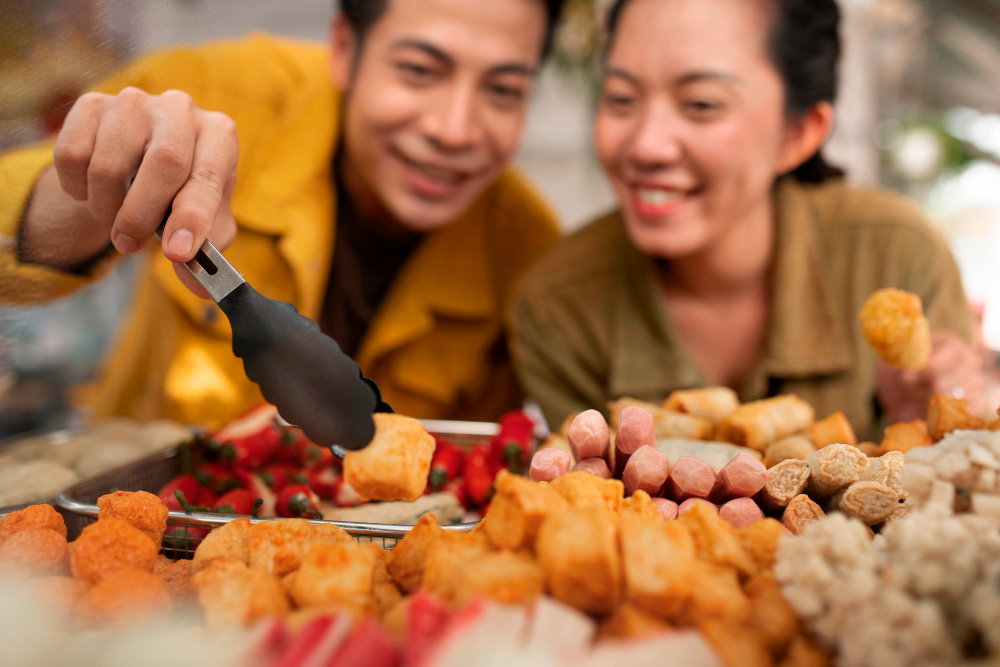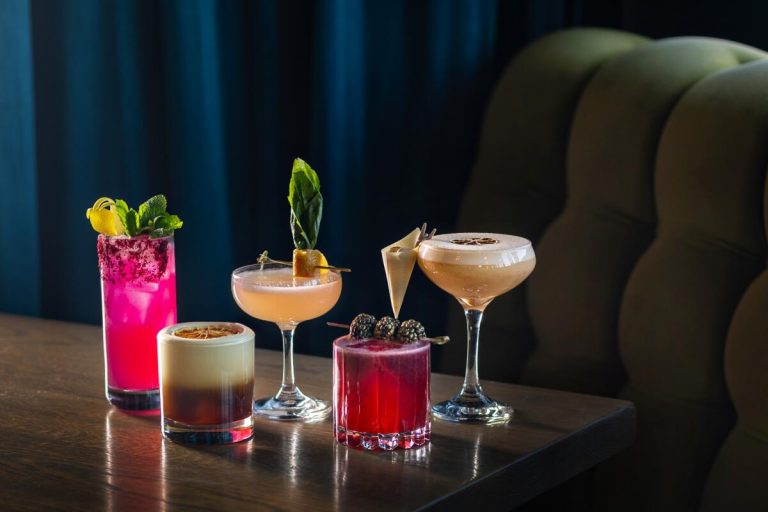If you’re a food lover deciding between Siem Reap and Singapore, Visit Siem Reap vs Singapore you’re in for a delicious dilemma. From traditional dishes that date back centuries to vibrant street food scenes and modern culinary innovations, both destinations offer unique flavors and experiences. Whether you’re drawn to the spicy tang of Cambodian Amok or the multicultural variety of Singapore’s hawker centers, this foodie face-off will help you choose your next culinary destination.
Let’s dive into 9 foodie adventures and compare Siem Reap vs Singapore to help you savor your next trip with taste and budget in mind.
1. Traditional Dishes: Amok vs Hainanese Chicken Rice
In Siem Reap, you’ll find Fish Amok—a national dish made with freshwater fish steamed in banana leaves with coconut milk, kroeung (Khmer curry paste), and herbs. It’s aromatic, creamy, and comforting.
In Singapore, the iconic Hainanese Chicken Rice is deceptively simple: poached chicken served with fragrant rice, garlic chili sauce, and ginger paste. Its perfection lies in the details—moist chicken and perfectly seasoned rice.
Winner: *Tie– Amok brings traditional flair while Chicken Rice is a Southeast Asian staple with a cult following.
2. Street Food Scene: Pub Street vs Hawker Centres
Siem Reap’s Pub Street is the heartbeat of its nightlife and casual dining. Street stalls offer skewers, spring rolls, and banana pancakes for \$1–\$3. From grilled frogs to tropical fruit shakes, the offerings are adventurous and budget-friendly.
Singapore’s hawker centres, such as Maxwell Food Centre, Old Airport Road, and Chinatown Complex, are UNESCO-listed and offer everything from laksa to satay. Dishes range from \$3–\$6, but the variety and cleanliness are unmatched.
Winner: *Singapore– The sheer scale, hygiene, and flavor depth give hawker centres a clear edge.
3. Unique Local Snacks
In Siem Reap, local snacks include fried crickets, silk worms, and tarantulas—not for the faint-hearted, but certainly unforgettable. If you want something more approachable, try num krok (rice and coconut pancakes).
Singapore, on the other hand, serves up local favorites like kaya toast, pandan cake, and ice cream sandwiches made with rainbow bread—unique, nostalgic, and perfect for sweet-toothed travelers.
Winner: *Singapore– While Siem Reap is more adventurous, Singapore wins for universal appeal and creativity.
4. Fine Dining: Khmer Cuisine vs Global Gastronomy
In Siem Reap, restaurants like Embassy and Malis elevate traditional Khmer cuisine into multi-course tasting menus for \$25–\$40—great value for gourmet experiences.
Singapore is a fine dining hub with Michelin-starred restaurants like Odette, Burnt Ends, and Labyrinth. Meals here can range from \$100 to \$300+, featuring everything from molecular gastronomy to reinvented heritage dishes.
Winner: *Siem Reap– For gourmet on a budget, Siem Reap wins. Singapore shines for high-end luxury if your wallet allows.
5. Night Markets: Siem Reap Night Market vs Lau Pa Sat
Siem Reap’s Angkor Night Market and Made in Cambodia Market combine food, crafts, and music. Enjoy local barbecue skewers, sweet sticky rice, and coconut pancakes while shopping for souvenirs.
Singapore’s Lau Pa Sat, especially at night, offers outdoor satay stalls and a buzzing vibe. While it’s more sanitized than Siem Reap’s night markets, it’s a foodie hotspot with historic charm.
Winner: *Siem Reap– The rustic vibe and food-shopping combo make Siem Reap’s night markets more atmospheric for budget travelers.
6. Cooking Classes and Culinary Tours
In Siem Reap, cooking classes are affordable and immersive. For \$20–\$30, you can visit a market, learn about Cambodian herbs, and prepare dishes like Lok Lak and banana flower salad. It’s hands-on and often includes a community or social enterprise element.
In Singapore, culinary workshops focus on precision and history. Learn how to make Peranakan dishes, dumplings, or laksa, but expect to pay \$60–\$100 for a class. The experience is more structured but also more refined.
Winner: *Siem Reap– Accessible prices and local authenticity give it the upper hand for culinary travelers.
7. Fusion Cuisine and Modern Twists
In Siem Reap, you’ll find a growing scene of fusion cafes blending Khmer flavors with international techniques. Think Khmer tacos, lemongrass burgers, and coconut-lime sorbets in hip settings.
Singapore is the capital of Asian fusion. From Mod-Sin (Modern Singaporean) restaurants to food courts experimenting with Japanese-Indian-Malay mashups, this is where flavors collide and flourish.
Winner: *Singapore– Innovation, variety, and culinary boldness give Singapore a strong lead in the fusion food scene.
8. Vegetarian and Vegan Options
Siem Reap is surprisingly vegan-friendly. Restaurants like Banlle, Vibe Café, and Chamkar specialize in plant-based Khmer and Western dishes. You can eat clean and green easily, with mains under \$6.
Singapore has a wide variety of vegetarian food—from Indian thalis in Little India to Buddhist vegetarian stalls at hawker centres. Western vegan cafes are also on the rise, though prices tend to be higher.
Winner: *Siem Reap– Affordable, authentic, and plentiful vegetarian options make it a great destination for conscious eaters.
9. Coffee and Café Culture
Siem Reap’s café scene is laid-back and artsy. You’ll find espresso bars in bamboo huts and cafes with garden seating, serving both local brews and international roasts. Prices range from \$1–\$3.
In Singapore, café culture is chic, with beautifully plated brunches and specialty coffee from roasters like Common Man and Tiong Hoe. It’s more expensive—expect to pay \$5–\$8 per coffee—but the quality and presentation are top-notch.
Winner: *Siem Reap– For relaxed, affordable coffee culture with charm, Siem Reap takes the crown.
Conclusion: Where Should Foodies Go?
In the ultimate foodie face-off of Siem Reap vs Singapore, both cities bring something deliciously unique to the table:
Choose Siem Reap if you’re an adventurous traveler on a budget, craving traditional flavors, immersive food experiences, and community-focused culinary adventures.
Choose Singapore if you’re a gourmet explorer looking for multicultural diversity, fusion creativity, and world-class food in a modern, hygienic setting.
The real foodies’ dream? Visit both. Start with the street-style simplicity of Siem Reap, then indulge in Singapore’s sophisticated eats—your taste buds will thank you.
FAQs
1. Is street food safe to eat in Siem Reap and Singapore?
Yes, but with caution:
Siem Reap: Choose busy stalls with high turnover, and avoid raw items.
Singapore: Very safe—hawker centres are regulated by authorities.
2. Are there halal food options in both cities?
Yes.
Siem Reap has a few halal restaurants and Muslim-friendly stalls.
Singapore has a wide variety of certified halal options across neighborhoods.
3. How much should I budget for daily food expenses?
Siem Reap: \$5–\$10 per day for local eats.
Singapore: \$15–\$25 per day if you stick to hawker centres and avoid upscale restaurants.
4. What’s the most Instagrammable dish in each city?
Siem Reap: Banana flower salad, coconut shakes, or colorful rice desserts.
Singapore: Rainbow ice cream sandwich, chili crab, or kaya toast with soft eggs.
5. Can I take a food tour in both cities?
Absolutely!
Siem Reap: Many budget-friendly food tours available via local companies.
Singapore: Join guided walks through Chinatown, Little India, or Michelin-rated hawker tours.
Also read : Los Angeles Cocktail Scene: Best Drinks & Where to Find Them




Leave a Comment